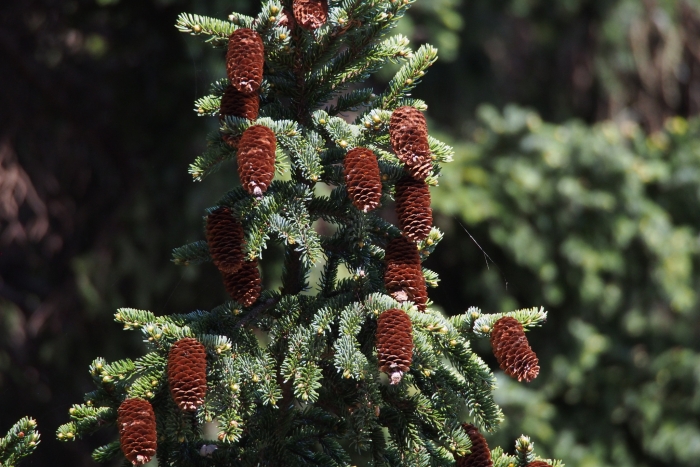Sakhalin Spruce
(Picea glehnii)
Sakhalin Spruce (Picea glehnii)
/
/

© harum.koh
CC BY-SA 4.0
Image By:
© harum.koh
Recorded By:
Copyright:
CC BY-SA 4.0
Copyright Notice:
Photo by: © harum.koh | License Type: CC BY-SA 4.0 | License URL: http://creativecommons.org/licenses/by-sa/4.0/ | Uploader: harumkoh | Publisher: iNaturalist |

























Estimated Native Range
Summary
Picea glehnii, commonly known as Sakhalin spruce or Glehn’s spruce, is an evergreen coniferous tree native to the subalpine and boreal forests of Hokkaido, Japan, and the Russian Far East, including Sakhalin Island and the Kuril Islands. It thrives in cool, moist environments and is adapted to a range of soil types, from well-drained volcanic soils to wet peatlands. Typically, this species reaches heights of up to 98 feet (30 meters) and is characterized by its chocolate brown scaly bark and a conical crown with dense, dark green needles. The tree produces small, purplish cones that mature to a pale brown.
Sakhalin spruce is valued for its cold hardiness and shade tolerance, making it suitable for northern landscapes and reforestation projects. It is also frost tolerant and can withstand harsh winter conditions. In cultivation, it requires moist, acidic soil and can tolerate partial shade, though it prefers full sun. While not commonly used in urban settings due to its large size, it is sometimes planted in large parks and naturalized areas. It is important to note that Sakhalin spruce can hybridize with Yezo spruce (Picea jezoensis), which may be a consideration for conservation and breeding programs. The tree is protected in several national parks and is listed in the Red Book of the Sakhalin region due to its conservation status.CC BY-SA 4.0
Sakhalin spruce is valued for its cold hardiness and shade tolerance, making it suitable for northern landscapes and reforestation projects. It is also frost tolerant and can withstand harsh winter conditions. In cultivation, it requires moist, acidic soil and can tolerate partial shade, though it prefers full sun. While not commonly used in urban settings due to its large size, it is sometimes planted in large parks and naturalized areas. It is important to note that Sakhalin spruce can hybridize with Yezo spruce (Picea jezoensis), which may be a consideration for conservation and breeding programs. The tree is protected in several national parks and is listed in the Red Book of the Sakhalin region due to its conservation status.CC BY-SA 4.0
Plant Description
- Plant Type: Tree
- Height: 80-100 feet
- Width: 25-30 feet
- Growth Rate: Slow, Moderate
- Flower Color: N/A
- Flowering Season: Non-Flowering
- Leaf Retention: Evergreen
Growth Requirements
- Sun: Full Sun, Part Shade
- Water: Medium
- Drainage: Medium
Common Uses
Bank Stabilization, Bird Garden, Low Maintenance
Natural Habitat
Subalpine and boreal forests of Hokkaido, Japan, and the Russian Far East, including Sakhalin Island and the Kuril Islands, in a range of soil types from well-drained volcanic soils to wet peatlands
Other Names
Common Names: Glehn’s Spruce, Aka-Ezomatsu, アカマツ (Aka-Matsu), 赤松 (Aka-Matsu)
Scientific Names: , Picea glehnii, Abies glehnii, Pinus glehnii,
GBIF Accepted Name: